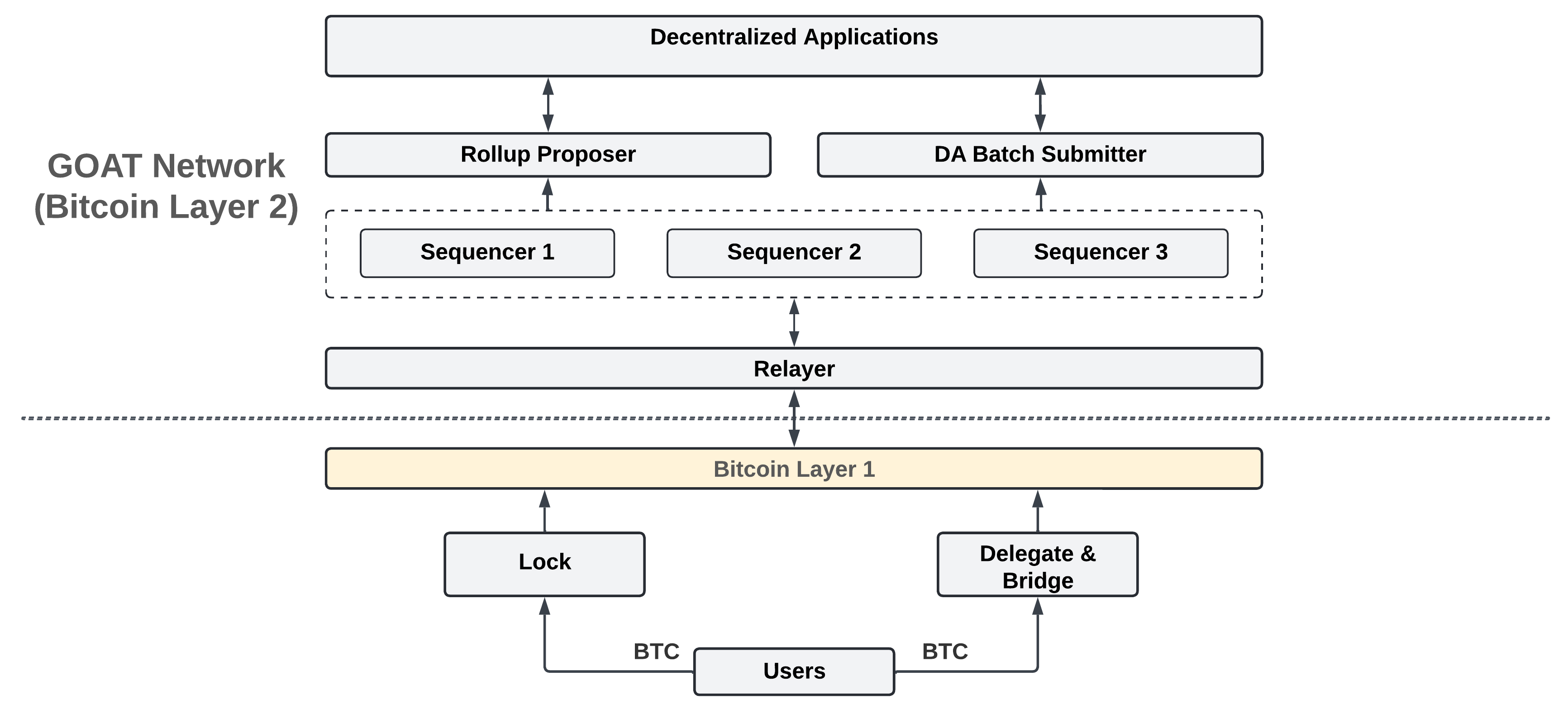Decentralized Sequencer
A sequencer is responsible for verifying, ordering, and compressing transactions on a Layer 2 (L2) rollup network before submitting them to the Bitcoin blockchain (Layer 1 or L1). For a comprehensive technical breakdown of our sequencing architecture, refer to our Technical Whitepaper (opens in a new tab). Unlike traditional centralized sequencers, GOAT Network introduces a decentralized sequencer model to enhance security, censorship resistance, and liveness from day one.
Key Features
- Trustlessness: Ensures that no single party can manipulate transaction order for profit.
- Censorship Resistance: Prevents any institution from censoring transactions or disrupting the consensus mechanism.
- Improved Liveness: Eliminates single points of failure and enhances the network's ability to remain operational even if some nodes fail.
Decentralized Sequencer Mechanism

Sequencer Network Initialization
- Staking: A candidate must make a staking transaction that locks their asset into a scriptTree output with three components: SlashScript, TimelockScript, and ContinueStakingScript.
- SlashScript: Slashes the staker’s asset if they misbehave during the consensus process, such as proposing two different blocks for the same slot.
- TimelockScript: Restricts the unlocking of the staker’s asset until a specified future time, ensuring that assets cannot be claimed prematurely.
- ContinueStakingScript: Allows the staker to continue staking if they fulfill their responsibilities and win the challenge/response game.
Rollup Batches Determination
- Transaction Submission: Users submit transactions to the RPC node of any sequencer. The RPC node forwards these transactions to the BridgeService and PoS Node.
- Batch Production: The PoS Node produces a transaction batch and notifies the RPC Node to seal it.
- Proposal Voting: The RPC Node fetches the batch, requests a proposal voting signature, and a one-time signature.
- Batch Submission: The batch submitter submits the batch with the one-time signature to the Bitcoin network, where it awaits potential challenges.
- Challenge Period: During this period, verifiers can initiate a challenge if they find the batch invalid. If no valid challenge is raised, the batch is settled on the Bitcoin network. If a challenge is successful, the sequencer’s staking is slashed, and a new epoch begins.
Benefits of Decentralized Sequencer
- Trustlessness: Centralized sequencers can manipulate transaction orders for profit. In contrast, decentralized sequencers achieve consensus through a distributed mechanism, ensuring that no single entity can control the transaction order.
- Censorship Resistance: Decentralized sequencers sort transactions through a consensus mechanism with nodes distributed globally, preventing any institution from censoring or hindering the network’s operation.
- Improved Liveness: Centralized sequencers are vulnerable to single points of failure. Decentralized sequencers, however, are resilient to such failures, with any malicious behavior being countered by the consensus mechanism.
Differentiation from Other Systems
GOAT Network's decentralized sequencer differs from systems like Babylon in several ways:
- Stability: Babylon allows staking to quit after the challenge window but before the timelock expires, which may reduce network stability if mining incentives fluctuate. GOAT Network, however, ensures high returns via universal native liquidity and allows stakers to continue staking during this period, significantly enhancing network stability and maintaining high liveness and censorship resistance.
By leveraging a decentralized sequencer model, GOAT Network achieves a robust, secure, and efficient transaction processing system that adheres to the principles of decentralization and trustlessness, essential for a scalable and secure Bitcoin Layer 2 solution.